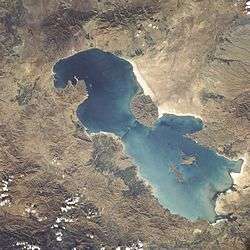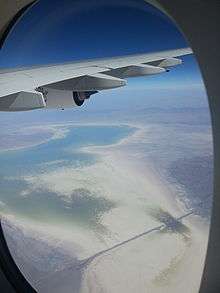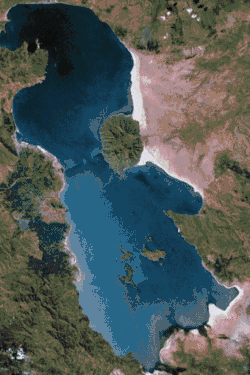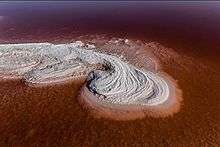Lake Urmia
| Lake Urmia | |
|---|---|
 Lake Urmia from space in 1984 | |
| Coordinates | 37°42′N 45°19′E / 37.700°N 45.317°ECoordinates: 37°42′N 45°19′E / 37.700°N 45.317°E |
| Type | salt (hypersaline) lake |
| Primary inflows | Zarriné-Rūd, Simineh-Rūd, Mahabad River, Gadar River, Barandouz River, Shahar River, Nazlou River, Zola River, Qatur River, Kaftar Ali Chay, Aji Chay, Boyuk Chay, Rudkhaneh-ye Qal'eh Chay, Qobi Chay, Rudkhaneh-ye Mordaq, Leylan River |
| Primary outflows | none: all water entering the lake is lost through evaporation |
| Basin countries | Iran |
| Max. length | 140 km (87 mi) |
| Max. width | 55 km (34 mi) |
| Surface area | 5,200 km2 (2,000 sq mi) |
| Max. depth | 16 m (52 ft) |
| Salinity |
217–235 g L−1 Na–(Mg)–Cl–(SO4) brine[1] 8–11% in spring, 26-28% in late autumn[2] |
| Islands | 102 (see list) |
| Official name | Lake Urmia [or Orumiyeh] |
| Designated | 23 June 1975 |
| Reference no. | 38[3] |


Lake Urmia (Persian: Daryāĉe Orumiye, Daryāche-ye Orumiye;, Urmiya gölü) is an endorheic salt lake in Iran.[4][5] The lake is between the provinces of East Azerbaijan and West Azerbaijan in Iran, and west of the southern portion of the Caspian Sea. At its greatest extent, it was the largest lake in the Middle East and the sixth-largest saltwater lake on Earth, with a surface area of approximately 5,200 km2 (2,000 sq mi), a length of 140 km (87 mi), a width of 55 km (34 mi), and a maximum depth of 16 m (52 ft).[6] The lake has shrunk to 10% of its former size due to damming of the rivers that flow into it, and the pumping of groundwater from the surrounding area.[7]
Lake Urmia, along with its once approximately 102 islands, is protected as a national park by the Iranian Department of Environment.
Names and etymologies
Currently, the lake is named after the provincial capital city of Urmia, originally an Assyrian name meaning puddle of water.
Its Old Persian name was Chichast, meaning "glittering", a reference to the glittering mineral particles suspended in the water of the lake and found along its shores. In medieval times it came to be known as Lake Kabuda (Kabodan),[8] from the word for "azure" in Persian, or 'կապույտ' (kapuyt) in Armenian. Its Latin name was Lacus Matianus, so it is referred to in some texts as Lake Matianus or Lake Matiene.
Locally, the lake is referred to in Persian as Daryāĉeye Orumiye, Daryāche-ye Orūmiye; in Azerbaijani as Urmu gölü, Kurdish "Zerivar-i Wermi". The traditional Armenian name is Կապուտան ծով, Kaputan tsov, literally "blue sea". Residents of Shahi Island refer to the lake in Azerbaijani as Daryā meaning Sea.[9][10][11]
Archaeology and history
The Lake Urmia region has a wealth of archaeological sites going back to the Neolithic period. Archaeological excavations of the settlements in the area have found artifacts that date from about 7,000 BCE and later.
Excavations at Teppe Hasanlu archeological site southwest of Lake Urmia also revealed habitations going back to the 6th millennium BC.
A related site is Yanik Tepe, on the east shore of Lake Urmia, that has been excavated in the 1950s and 60s by C. A. Burney.[12]
Another important site in the area, from about the same era, is Hajji Firuz Tepe, where some of the oldest archaeological evidence of grape-based wine was discovered.
Kul Tepe Jolfa is a site in the Jolfa County about 10 km south from the Araxes River. It dates to Chalcolithic period (5000–4500 BC).
Se Girdan kurgans are located on the south shore of Lake Urmia. Some of them were excavated in 1968 and 1970 by O. Muscarella. They have now been redated to the second half of the 4th millennium, although originally they were thought to be much younger.[13]
One of the early mentions of Lake Urmia is from Assyrian records of the 9th century BCE. There, in the records from the reign of Shalmaneser III (858–824 BCE), two names are mentioned in the area of Lake Urmia: Parsuwaš (i.e. the Persians) and Matai (i.e. the Mitanni). It is not completely clear whether these referred to places or tribes, or what their relationship was to the subsequent list of personal names and "kings". But the Matai were Medes and linguistically the name Parsuwaš matches the Old Persian word pārsa, an Achaemenid ethnolinguistic designation.[14]
The lake was the center of the Mannaean Kingdom. A potential Mannaean settlement, represented by the ruin mound of Hasanlu, was on the south side of the lake. Mannae was overrun by the Matiani or Matieni, an Iranian people variously identified as Scythian, Saka, Sarmatian, or Cimmerian. It is not clear whether the lake took its name from the people or the people from the lake, but the country came to be called Matiene or Matiane, and gave the lake its Latin name.
The Battle of Urmia was fought near the lake in 1604, during the Ottoman–Safavid War of 1603–1618.
In the last five hundred years the area around Lake Urmia has been home to Iranians, Assyrians, and Armenians.
Chemistry
The main cations in the lake water include Na+, K+, Ca2+, Li+ and Mg2+, while Cl−, SO2−
4, HCO−
3 are the main anions. The Na+ and Cl− concentration is roughly four times the concentration of natural seawater. Sodium ions are at slightly higher concentration in the south compared to the north of the lake, which could result from the shallower depth in the south, and a higher net evaporation rate.
The lake is divided into north and south, separated by the Urmia Lake Bridge and its associated causeway, which was completed in 2008. The bridge provides only a 1.5-kilometre (0.93 mi) gap in the embankment, allowing little exchange of water between the two sections. Due to drought and increased demands for agricultural water in the lake's basin, the salinity of the lake has risen to more than 300 g/l during recent years, and large areas of the lake bed have been desiccated.[15]

Ecology
Palaeoecology
A palynological investigation on long cores from Urmia Lake has revealed a nearly 200 kyr record of vegetation and lake level changes. The vegetation has changed from the Artemisia/grass steppes during the glacial/stadial periods, to oak-juniper steppe-forests during the interglacial/interstadial periods. The lake has had a complex hydrological history and its water levels have fluctuated greatly in geological history. Very high lake levels have been suggested for some time intervals during the two last glacial periods, as well as during both the Last Interglacial as well as the Holocene. The lowest lake levels have occurred during the last glacial periods.
Modern ecology
Based on the latest checklists of biodiversity at Lake Urmia in 2014 and 2016, it is home of 62 species of archaebacteria and bacteria, 42 species of microfungi, 20 species of phytoplankton, 311 species of plants, five species of mollusca, 226 species of birds, 27 species of amphibians and reptiles and 24 species of mammals (47 fossils have been recorded in the area).[18][19]
Lake Urmia is an internationally registered protected area as both a UNESCO Biosphere Reserve[17] and a Ramsar site.[20] The Iranian Dept. of Environment has designated most of the lake as a National Park.[21]
The lake is marked by more than a hundred small, rocky islands, which serve as stopover points during the migrations of a number of bird species, including flamingos, pelicans, spoonbills, ibises, storks, shelducks, avocets, stilts, and gulls. A recent drought has significantly decreased the annual amount of water the lake receives. This in turn has increased the salinity of the lake's water, reducing its viability as home to thousands of migratory birds, including a large flamingo populations. The salinity has particularly increased in the half of the lake north of the Urmia Lake Bridge.
By virtue of its high salinity, the lake no longer sustains any fish species. Nonetheless, Urmia Lake is considered a significant natural habitat of Artemia, which serve as food source for the migratory birds such as flamingos.[22] In early 2013, the then-head of the Iranian Artemia Research Center was quoted that Artemia urmiana had gone extinct due to the drastic increases in salinity. However this assessment has been contradicted,[23] and another population of this species has recently been discovered in the Koyashskoye Salt Lake at the Crimean Peninsula.[24]
Falling level and increasing salinity
The lake is a major barrier between Urmia and Tabriz, two of the most important cities in the provinces of West Azerbaijan and East Azerbaijan. A project to build a highway across the lake was initiated in the 1970s but was abandoned after the Iranian Revolution of 1979, leaving a 15 km (9.3 mi) causeway with an unbridged gap. The project was revived in the early 2000s, and was completed in November 2008 with the opening of the 1.5 km (0.93 mi) Urmia Lake Bridge across the remaining gap.[25] The highly saline environment is already heavily rusting the steel on the bridge despite anti-corrosion treatment. Experts have warned that the construction of the causeway and bridge, together with a series of ecological factors, will eventually lead to the drying up of the lake, turning it into a salt marsh, which will adversely affect the climate of the region.
Lake Urmia has been shrinking for a long time, with an annual evaporation rate of 0.6 to 1 m (24 to 39 in). Although measures are now being taken to reverse the trend[26] the lake has shrunk by 60% and could disappear entirely.[26] Only 5% of the lake's water remains.[27]
On 2 August 2012, Muhammad-Javad Muhammadizadeh, the head of Iran's Environment Protection Organization, announced that Armenia had agreed on transfer water from Armenia to counter the critical fall in Lake Urmia's water level, remarking that "hot weather and a lack of precipitation have brought the lake to its lowest water levels ever recorded". He added that recovery plans for the lake included the transfer of water from Eastern Azerbaijan Province. Previously, Iranian authorities had announced a plan to transfer water from the Aras River, which borders Iran and Azerbaijan, but the 950-billion-toman plan was abandoned due to Azerbaijan's objections.[28]

In July 2014, Iran President Hassan Rouhani approved plans for a 14 trillion rial program (over $500 million) in the first year of a recovery plan. The money is supposed to be used for water management, reducing farmers' water use, and environmental restoration. Several months earlier, in March 2014, Iran's Department of Environment and the United Nations Development Programme (UNDP) issued a plan to save the lake and the nearby wetland, which called for spending $225 million in the first year and $1.3 billion overall for restoration.[29]
Starting in 2016, Food and Agriculture Organization of the United Nations (FAO) and Urmia Lake Restoration Program (ULRP) signed up to a project funded by the Government of Japan entitled "An Integrated Programme for Sustainable Water Resources Management in the Lake Urmia Basin" to support ULRP in its goal to restore Lake Urmia. The project set out a multi-disciplinary framework covering several key interrelated areas and aims to have five outputs: 1. An advanced water accounting (WA) system for the entire Lake Urmia basin; 2. A drought management system based on risk/vulnerability assessment and preparedness response for the basin; 3. A socio-economic livelihood programme with viable and sustainable alternatives to current agricultural activities upstream of the lake to reduce water consumption significantly while maintaining the income and livelihood of affected communities; 4. An integrated watershed management (WM) programme; A capacity development programme to strengthen stakeholders at different levels.
The Silveh Dam in Piranshahr County should be complete in 2015. Through a tunnel and canals it will transfer up to 121,700,000 m3 (98,700 acre⋅ft) of water annually from the Lavin River in the Little Zab basin to Lake Urmia basin.[30][31][32]
In 2015, president Hassan Rouhani's cabinet approved $660 million for improving irrigation systems, and steps to combat desertification.[33]
In September 2018, A working group tasked with reviving Lake Urmia has started to grow two types of plants to save the region from salt particles.The two plants are “Nitraria” or Karadagh and “Tamarix” or Shoorgaz, which are planted on the land of Jabal Kandi village in Urmia County, to slow down the wind that brings with itself the salt particles.[34]
Environmental protests

The prospect that Lake Urmia might dry up entirely has drawn protests in Iran and abroad, directed at both the regional and national governments. Protests flared in late August 2011 after the Iranian parliament voted not to provide funds to channel water from the Araz River to raise the lake level.[35][36] Apparently, parliament proposed instead to relocate people living around Urmia Lake.[36]
More than 30 activists were detained on 24 August 2011 during an iftar meal.[36] In the absence of a right to protest publicly in Iran, protesters have incorporated their messages into chants at football matches.[35][37] On 25 August, several soccer fans were detained before and after the Tabriz derby match between Tractor Sazi F.C. and Shahrdari Tabriz F.C.. for shouting slogans in favor of protecting the lake, including "Urmia Lake is dying, the Majlis [parliament] orders its execution".[35][36][38][39]
Further demonstrations took place in the streets of Tabriz and Urmia on 27 August and 3 September 2011.[35][37][40] Amateur video from these events showed riot police on motorcycles attacking apparently peaceful protesters.[37][41] According to the governor of West Azerbaijan, at least 60 supporters of the lake were arrested in Urmia, and dozens in Tabriz, because they had not applied for a permit to organize a demonstration.[42]
On May 5, 2016, Leonardo Di Caprio posted a photo of "a dilapidated ship dock remains on dried up Urmia Lake" on his Instagram page stating: "It used to be the biggest salt lake in the Middle East, but it now contains five percent of the amount of water it did two decades ago due to climate change, dam construction and decrease in precipitiation."[43]
Islands
Lake Urmia had approximately 102 islands.[44] Shahi Island was historically the lake's largest. However, it became a peninsula connected to the eastern shore when the lake level dropped.[1][45]
Shahi Island is the burial place of both Hulagu Khan (one of Genghis Khan's grandsons) and of Hulagu's son Abaqa. Both khans were buried in a castle above 1,000-foot (300 m) cliffs along the shore of the island.[46]
In 1967, the Iranian Department of Environment sent a team of scientists to study the ecology of Shahi Island. Various results of the study, which included the breeding habits of brine shrimp, were published by Javad Hashemi in the scientific journal, Iranian Scientific Sokhan.
Basin rivers
Lake Urmia is fed by 13 permanent rivers and many small springs, as well as rainfall directly into the lake.[1] Nearly half the inflow comes from the Zarrineh River and Simineh River.[1] There is no outflow from the lake so water is only lost through evaporation.[1]
In popular culture
Lake Urmia was the setting of the Iranian film The White Meadows (2009), which featured fantastic-looking lands adjacent to a salt sea. There are many popular songs about Lake Urmia in Azeri Turkish, such as "Urmu Golu Lay Lay".[47]
See also
References
- 1 2 3 4 5 Stevens, Lora R.; Djamali, Morteza; Andrieu-Ponel, Valérie; de Beaulieu, Jacques-Louis (1 April 2012). "Hydroclimatic variations over the last two glacial/interglacial cycles at Urmia Lake, Iran" (PDF). Journal of Paleolimnology. Springer Netherlands. 47 (4): 647. doi:10.1007/s10933-012-9588-3.
- ↑ Urmia Lake. 2012. Encyclopædia Britannica Online. Retrieved 14 August 2015, from http://www.britannica.com/EBchecked/topic/619901/Lake-Urmia
- ↑ "Lake Urmia [or Orumiyeh]". Ramsar Sites Information Service. Retrieved 25 April 2018.
- ↑ Henry, Roger (2003) Synchronized chronology: Rethinking Middle East Antiquity: A Simple Correction to Egyptian Chronology Resolves the Major Problems in Biblical and Greek Archaeology Algora Publishing, New York, p. 138, ISBN 0-87586-191-1
- ↑ E. J. Brill's first encyclopaedia of Islam, 1913–1936, vol. 7, page 1037 citing Strabo and Ptolemy.
- ↑ "Britanica". Britannica.com. Retrieved 4 September 2011.
- ↑ "Saving Iran's great salt lake". Science. September 2, 2015.
- ↑ See, e.g. the Shahnama.
- ↑ Amurian, A.; Kasheff, M. (15 December 1986). "Armenians of modern Iran". Encyclopædia Iranica.
Urmia (class. Arm. Kaputan) ...
- ↑ Russell, James R. (1987). Zoroastrianism in Armenia. Harvard University. p. 430.
Urmia Lake, called Kaputan cov by Arm. geographers :...
- ↑ "Armenian Highland". armin.am. Institute for Armenian Studies of Yerevan State University.
In the Armenian Highland there are numerous lakes and ponds. The most majors are Kaputan (Urmia), Van and Sevan.
- ↑ C. A. Burney, Excavations at Yanik Tepe, North-West-Iran, Iraq 23, 1961, pp. 138ff.
- ↑ O. W. Muscarella, “The Chronology and Culture of Se Girdan: Phase III,” Ancient Civilizations from Scythia to Siberia 9/1-2, 2003, pp. 117-31
- ↑ cf. Skjærvø, Prods Oktor (2006), "Iran, vi(1). Earliest Evidence", Encyclopaedia Iranica, Vol. 13
- ↑ Alireza Asem; Fereidun Mohebbi; Reza Ahmadi (2012). "Drought in Urmia Lake, the largest natural habitat of brine shrimp Artemia" (PDF). World aquaculture. 43: 36–38.
- ↑ "Saline Systems; Urmia Salt Lake, Iran". Salinesystems.org. Retrieved 4 September 2011.
- 1 2 "UNESCO Biosphere Reserve Directory".
- ↑ Asem A., Eimanifar A., Djamal M., De los Rios P. and Wink M. (2014) Biodiversity of the Hypersaline Urmia Lake National Park (NW Iran), Diversity, 6: 102-132.
- ↑ Asem A., Eimanifar A. and Wink M. (2016) Update of "Biodiversity of the Hypersaline Urmia Lake National Park (NW Iran)". Diversity, 8: 6, doi:10.3390/d8010006
- ↑ Ramsar Sites Information Service
- ↑ ProtectedPlanet - Urumieh lake
- ↑ C. Michael Hogan. 2011. Urmia Lake. Eds. P. Saundry & C. J.Cleveland. Encyclopedia of Earth. National Council for Science and the Environment. Washington, D.C.
- ↑ Critical condition of Artemia urmiana and possibility of extinction
- ↑ Eimanifar A; Asem A; Djamali M; Wink M (2016). "A note on the biogeographical origin of the brine shrimp Artemia urmiana Günther, 1899 from Urmia Lake, Iran". Zootaxa. 4097 (2): 294–300. doi:10.11646/zootaxa.4097.2.12.
- ↑ "Iran's East and West Azerbaijan Provinces Connected by Lake Orumiyeh Bridge". Payvand.com. Retrieved 4 September 2011.
- 1 2 Karmi N. Iran's largest lake turning to salt. Associated Press 25 May 2011. https://news.yahoo.com/s/ap/20110525/ap_on_re_mi_ea/ml_iran_environmental_disaster/print
- ↑ Erdbrink, Thomas (30 January 2014). "Its Great Lake Shriveled, Iran Confronts Crisis of Water Supply". New York Times. Archived from the original on 2 September 2014. Retrieved 11 May 2017.
- ↑ http://www.payvand.com/news/12/aug/1010.html
- ↑ https://www.newscientist.com/article/dn25850-iran-to-spend-500-million-to-save-shrunken-lake-urmia.html#.U7nrg41dXvI
- ↑ "Completed by the end of the 94 dams Silveh Piranshahr" (in Persian). Kurd Press. 23 August 2014. Archived from the original on 20 January 2015. Retrieved 20 January 2015.
- ↑ "Silveh Dam and Irrigation and Drainage" (in Persian). Omran Iran - Deputy Governor of West Azerbaijan. Archived from the original on 20 January 2015. Retrieved 20 January 2015.
- ↑ Edris Merufinia; Azad Aram; Fatemeh Esmaeili (2014). "Saving the Urmia Lake: from Slogan to Reality (Challenges and Solutions)" (PDF). Bulletin of Environment, Pharmacology and Life Sciences. 3 (3). ISSN 2277-1808. Retrieved 20 January 2015.
- ↑ Saving Iran’s great salt lake - sciencemag.org - 2 September 2015
- ↑ https://ifpnews.com/exclusive/iran-using-plants-to-fight-dust-pollution-in-lake-urmia/
- 1 2 3 4 Mackey, Robert (30 August 2011). "Protests in Iran Over Disappearing Lake". Iran: New York Times. Retrieved 4 September 2011.
- 1 2 3 4 "Azeri Activists Detained In Iran For Environmental Protests". RFE/RL. 26 August 2011. Retrieved 12 November 2015.
- 1 2 3 "Iranian greens fear disaster as Lake Orumieh shrinks". The Guardian. London. 5 September 2011.
- ↑ "Rally protesting Iran over Urmia Lake turns violent". Hurriyet Daily News. 1 September 2011. Retrieved 4 September 2011.
- ↑ "Iranian Protest Urges Help for Shrinking Lake". San Francisco Chronicle. 30 August 2011. Retrieved 4 September 2011.
- ↑ "Azeri Turks in Ankara protest Urmia Lake drying up". todayszaman.com. Archived from the original on 6 September 2011. Retrieved 4 September 2011.
- ↑ "Iran police break up environmental protests". euronews.net. 4 September 2011. Retrieved 4 September 2011.
- ↑ "Iran arrests saltwater lake protesters". BBC. 4 September 2011. Retrieved 4 September 2011.
- ↑ https://www.instagram.com/p/BFAZvGAKxHi/?taken-by=leonardodicaprio&hl=en
- ↑ List from: Farahang-e Joghrafiyayi-e shahrestânhâ-ye Keshvar (Shahrestân-e Orumiyeh), Tehran 1379 Hs.
- ↑ Asem, Alireza; Eimanifar, Amin; Djamali, Morteza; De los Rios, Patricio; Wink, Michael (2014). "Biodiversity of the Hypersaline Urmia Lake National Park (NW Iran)". Diversity (6): 102–132. doi:10.3390/d6020102.
- ↑ Boyle, John Andrew (1974). "The Thirteenth-Century Mongols' Conception of the After Life: The Evidence of their Funerary Practices". Mongolian Studies. Mongolia Society. 1: 7. ISSN 0190-3667. JSTOR 43193015.
- ↑ https://www.youtube.com/watch?v=dLB9bLOKalY
External links
| Wikimedia Commons has media related to Lake Urmia. |
- Iranica Encyclopedia: Eckhart Ehlers, "Lake Urmia", 2013
- Encyclopedia of Earth: C. Michael Hogan, "Lake Urmia", 2011
- Saline Systems; Urmia Salt Lake, Iran
- Profile at UNESCO Biosphere Reserve Directory
- Palaeoecological significance of the spores of the liverwort Riella (Riellaceae) in a late Pleistocene long pollen record from the hypersaline Lake Urmia, NW Iran
- A late Pleistocene long pollen record from Lake Urmia, NW Iran
- Evaluation of dike-type causeway impacts on the flow and salinity regimes in Urmia Lake, Iran
- Iran's Environmental Ticking Bomb
- www.urmiyalake.blogveb.com
- Iran's Dam Policy and The Case of Lake Urmia by Ercan AYBOGA & Akgün ILHAN
- Panorama picture of Lake Urmia by Armin Jalili
- Tishineh
- Landsat - Drying of Lake Urmia, Iran, Google Earth Engine
- Aerial view of Lake Urmia
